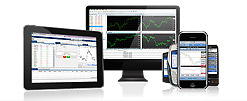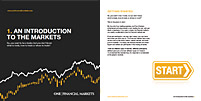

COMMON TRADING MISTAKES AND HOW TO AVOID THEM
8th August 2019
There are dozens of trading mistakes that traders, both novice and experienced, make. The following are seven of the most common, avoidable mistakes. If you can avoid these mistakes, your profitability should improve quickly.
1. Taking impulse trades
This is the first mistake most traders make. An impulse trade is one you take without a plan or strategy. Usually, it happens because you see a price begin to move and you don’t want to miss out. The problem is that you have no idea where your target is, where your stop loss is, and why you actually have the position.
Keeping a trading journal will force you to provide reasons for each trade. Pretty soon you will realise that when you are about to take an impulse trade, you’re going to have to come up with a reason for your journal. That will make you think twice about taking the trade.
2. Taking marginal trades
Marginal trades are trades that technically may be profitable, but only just. The expected profit will be small and will probably be wiped out by sloppy execution. You are most likely to take these trades out of boredom when markets are quiet and there aren’t any good opportunities. The problem is that they will consume your attention and energy, and you’re likely to miss better opportunities when they come.
To avoid marginal trades, you can try to find something else to occupy your time when markets are just too quiet. Alternatively, you can set a minimum expectancy that you will accept for a trade. Focussing on improving your trading stats will also make you think twice about taking trades with low expectancy.
3. Forgetting or not being aware of expected news releases
This is a mistake every trader makes a few times at least. All too often, a great looking opportunity comes along just before a major data release is due. Except that you don’t know about the news. You enter the trade and five minutes later you have been stopped out by a large and unexpected move.
One of the things a trader must do every single day is to check an economic calendar for expected news and data releases. This is just a habit every trader needs to get into. If you are forgetful, you can set an alert on your desktop to remind you 5 minutes before the release.
4. Using a fixed stop loss on each trade
You need to adapt to changing market conditions, and that goes for stop losses too. Traders often set their stops the same percentage or number of pips from the entry price regardless of the current market.
There are several ways to set stops in your trading portfolio. Personal preferences are fine, but you should at least adjust the size of your stop as volatility rises and falls.
5. Holding highly correlated positions
If you have several positions in your trading portfolio, management of risk is key. Holding highly correlated instruments means you have concentration risk because these assets often move together.
Emerging market currencies are correlated, as are the AUD and NZD, and gold and the CHF. The same goes for stocks – banking stocks are correlated; semiconductor stocks are correlated, and retailers are correlated. A portfolio is only really diversified when the correlation is low.
6. Focussing on profit and loss (P&L) instead of on trading well
The reality when trading is that your portfolio value will oscillate. Obsessing over your account value will increase your anxiety, and that will negatively affect your trading performance.
Rather obsess over how well you execute your trades and how well you manage to stick to your trading plan. Ignore your P&L during the day and focus on the trading – your account will be fine if you trade well.
7. Buying into resistance, selling into support
All too often traders see a great setup on a lower timeframe and jump into a trade without considering what the higher timeframe looks like. If there is a major support or resistance level right where you enter your trade, the odds of it working out are low.
You can prevent this by getting into the habit of drilling down from higher to lower timeframes on a daily basis for all the instruments you are trading. Start with the weekly, then the daily, 4-hourly and then the hourly. If you do that every day before the market opens you will be aware of the bigger trends at play, and how they may affect the time frame you are trading.
All content is provided for your information only.
This article may contain opinions and is not advice or a recommendation to buy, sell or hold any investment. No representation or warranty is given on the present or future value or price of any investment, and investors should form their own view on any proposed investment. This article has not been prepared in accordance with legal requirements designed to promote the independence of investment research and is considered a marketing communication. Non-independent research is not subject to FCA rules prohibiting dealing ahead of research, however we have put controls in place (including dealing restrictions, physical and information barriers) to manage potential conflicts of interest presented by such dealing.
One Financial Markets expressly disclaims all liability from actions or transactions arising out of the usage of this content. By using our services, you expressly agree to hold One Financial Markets harmless against any claims whatsoever and confirm that your actions are at your sole discretion and risk.
Begin trading today! Create an account by completing our form
Privacy Notice
At One Financial Markets we are committed to safeguarding your privacy.
Please see our Privacy Policy for details about what information is collected from you and why it is collected. We do not sell your information or use it other than as described in the Policy.
Please note that it is in our legitimate business interest to send you certain marketing emails from time to time. However, if you would prefer not to receive these you can opt-out by ticking the box below.
Alternatively, you can use the unsubscribe link at the bottom of the Demo account confirmation email or any subsequent emails we send.
By completing the form and downloading the platform you agree with the use of your personal information as detailed in the Policy.






